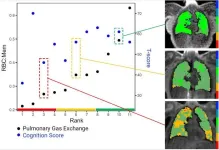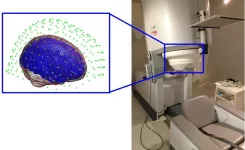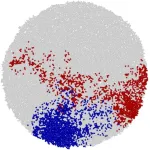(Press-News.org) Let’s say it’s a home game for the Golden State Warriors and Steph Curry shows he’s still got it, sinking back-to-back three-pointers minutes into the first quarter. The fans at Chase Center take notice, and so do the betting markets, where the odds move in the Warriors’ favor.
Yet it’s a long game. The away team comes back, and with just 10 seconds to go, the Warriors are down by two and have just missed a shot. A victory is unlikely, and the betting odds should have shifted to reflect that near-certainty. But they don’t.
“If you look at the history of NBA games, the probability that a team with the ball, up by two with 10 seconds left, wins is north of 90%,” says Eben Lazarus, an assistant professor of finance at UC Berkeley’s Haas School of Business. “But what shows up in the betting markets is that people treat baskets as too similar over the course of the game. They overreact to information that’s not very important—early baskets—and underreact to strong signals at the end.”
This interesting pattern in how people interpret new information holds true across a range of settings, from sports betting to financial markets, according to a new paper published in the Quarterly Journal of Economics. Lazarus and coauthors Ned Augenblick from UC Berkeley Haas and Michael Thaler of University College London conducted three experiments and analyzed millions of betting transactions and prices on options contracts, and found that people consistently overreact to weak information and underreact to strong information.
“There are all kinds of situations where I might know whether piece of news is good or bad, but struggle to judge exactly how important it is,” Lazarus says. “We saw this pattern everywhere we looked, which was surprising to us given the stakes involved in betting and financial markets.”
Building on decades of behavioral science and economics research
Lazarus and his coauthors wanted a way to unify different theories about how people act in ways that aren’t quite rational when processing new information. The study builds on decades of behavioral psychology and economics research about how people update their beliefs given new information, dating back to a classic 1966 paper arguing people are overly cautious in updating, and a 1992 paper by Dale Griffin and Amos Tversky showing people tend to overfocus on information that seems dramatic but give less weight to how reliable it is.
More recent papers have shown that people make systematic errors as a result of mistakes in calculating probabilities, and when people are uncertain about what decision to make they tend to pick a middle-ground option. The paper also connects to studies looking at how financial markets sometimes overreact and sometimes underreact to news.
“We think that we have a simple framework for thinking systematically through a lot of situations in the financial markets and the real world,” he says.
As humans, we take in information all the time, whether it’s a new poll that favors our preferred candidate or feedback from a boss. The researchers theorized that most of the time we don’t have the information to accurately judge just how important that information is, so we tend default to a middle ground.
“In cases where it’s easy to figure out which direction to update your beliefs, but not quite how much you should update, people will tend to treat all ‘good’ information somewhat similarly,” he says. “Given this difficulty, you’re going to see people overreacting to news that’s fairly weak and underreacting to news that should move you close to certainty.”
Experimental evidence
The research team first tested their theory in lab experiments, including both a classic experiment involving determining which deck a particular card came from and a novel sports-related experiment where they recruited 500 NBA fans and presented them with sequences of events in a simulated basketball game. The simulations started with 2:40 left in each quarter, and participants then saw a sequence of four possessions. After each possession, participants had to predict the probability of each team winning (they could earn a $50 bonus based on their accuracy).
The researchers established the “correct” probabilities of wins in each scenario using data from the website inpredictable.com. But they found that while people understood that late-game baskets were more important than those scored early in the, they still overreacted to first-quarter baskets—giving them 60% more importance than they should—and underweighted fourth-quarter baskets by 33%.
“This gave us a good sense that people were over- or under-reacting to information in experiments, but we needed to come up with some ways to test this in higher-stakes settings in the real world,” Lazarus says.
Sports betting data from Betfair
To do that, the research team turned to sports prediction market Betfair, analyzing over 5 million betting transactions across 260,000 basketball, soccer, football, and ice hockey games. Since the researchers had no way to determine the “correct” probability of a win with certainty, they developed a new empirical method to measure whether prices were over- or underreacting to information. Again, they found that early in games, events like scores created bigger shifts in betting odds than they should have, given the high uncertainty about the outcome. Meanwhile, important events like fourth-quarter goals caused smaller shifts in the market than is justified.
Data from options markets
Lazarus and his coauthors also tested their theory in a sophisticated financial market, using option price quotes for S&P index options traded on the Chicago Board Options Exchange from 1996 to 2018. After applying multiple filters, they had over 4 million option prices corresponding to 955 expiration dates. To give a clear time horizon, they focused on those expiring in 100 trading days (~4.5 months).
They found the same pattern they observed in the sports betting market.
“…News today appears to hold relatively little information about the value of the S&P in multiple months, but the market acts as if it (does),” the authors write. “However, within two weeks of a contract’s resolution, the relationship reverses…as signals become stronger, the market begins to underreact.”
Real-world implications
While the research explains some puzzling patterns in how people and markets respond to news, Lazarus cautions that being aware of these patterns does not remove all risk.
“It’s still not a free lunch if you know that on average markets are underreacting or overreacting at different points in time,” he says. “You can still lose a lot of money if you bet against these moves.”
Still, the findings suggest that it’s wise to pay attention to how much weight to give different pieces of information, even in situations that are far more ambiguous.
“Let’s say I have a negative interaction with my boss and I’ve spent all week fretting about it,” he says. “How important is it really for my future at this company? I think people would do well to take that step back and think about how much to react.”
About the paper
Overinference from Weak Signals and Underinference from Strong Signals
By Ned Augenblick, Eben Lazarus, and Michael Thaler
The Quarterly Journal of Economics, October 14, 2024
END
Sports betting and financial market data show how people misinterpret new information in predictable ways
In a new paper published in the Quarterly Journal of Economics, researchers found an interesting pattern in how people interpret new information.
2024-11-26
ELSE PRESS RELEASES FROM THIS DATE:
Long COVID brain fog linked to lung function
2024-11-26
CHICAGO – In patients with long COVID, lower pulmonary gas exchange may be associated with impaired cognitive function, according to a study being presented next week at the annual meeting of the Radiological Society of North America (RSNA).
According to the National Center for Health Statistics, approximately 17.6% of adults in the U.S. have experienced a post-COVID condition commonly referred to as long COVID. People with long COVID may exhibit a wide variety of symptoms, including difficulty concentrating (“brain fog”), change in sense of smell or taste, fatigue, joint or muscle pain, dyspnea (shortness of breath), digestive ...
Concussions slow brain activity of high school football players
2024-11-26
CHICAGO – A new study of high school football players found that concussions affect an often-overlooked but important brain signal. The findings are being presented next week at the annual meeting of the Radiological Society of North America (RSNA).
Reports have emerged in recent years warning about the potential harms of youth contact sports on developing brains. Contact sports, including high school football, carry a risk of concussion. Symptoms of concussion commonly include cognitive disturbances, such as difficulty with balancing, ...
Study details how cancer cells fend off starvation and death from chemotherapy
2024-11-26
Laboratory experiments with cancer cells reveal two ways in which tumors evade drugs designed to starve and kill them, a new study shows.
While chemotherapies successfully treat cancers and extend patients’ lives, they are known not to work for everyone for long, as cancer cells rewire the process by which they convert fuel into energy (metabolism) to outmaneuver the drugs’ effects. Many of these drugs are so-called antimetabolics, disrupting cell processes needed for tumor growth and survival.
Three such drugs used in the study — raltitrexed, N-(phosphonacetyl)-l-aspartate (PALA), and brequinar ...
Transformation of UN SDGs only way forward for sustainable development
2024-11-26
Climate change is the single biggest threat to the global environment and socio-economic development – demanding an urgent transformation of the United Nations’ Sustainable Development Goals (SDGs), according to a new study.
The UN SDGs were created to end poverty, build social-economic-health protection and enhance education and job opportunities, while tackling climate change and providing environmental protection.
Following last week’s COP29 environmental summit in Baku, University of Birmingham experts say that, as climate action is linked to sustainable development, systematic integration of climate resilience into every ...
New study reveals genetic drivers of early onset type 2 diabetes in South Asians
2024-11-26
UNDER STRICT EMBARGO UNTIL 10.00AM (UK TIME) ON 26 NOVEMBER 2024
New study reveals genetic drivers of early onset type 2 diabetes in South Asians
Peer reviewed | Observational study | People
A genetic predisposition to having lower insulin production and less healthy fat distribution are major causes of early-onset type 2 diabetes in British Asian people. According to new research from Queen Mary University of London, these genetic factors also lead to quicker development of health complications, earlier need for insulin treatment, and a weaker response ...
Delay and pay: Tipping point costs quadruple after waiting
2024-11-26
RICHLAND, Wash. —Tip the first tile in a line of dominoes and you’ll set off a chain reaction, one tile falling after another. Cross a tipping point in the climate system and, similarly, you might spark a cascading set of consequences like hastened warming, rising sea levels and increasingly extreme weather.
It turns out there’s more to weigh than catastrophic environmental change as tipping points draw near, though. Another point to consider, a new study reveals, is the cost of undoing the damage.
The cost of reversing the effects of climate change—restoring melted polar sea ice, for ...
Magnetic tornado is stirring up the haze at Jupiter's poles
2024-11-26
While Jupiter's Great Red Spot has been a constant feature of the planet for centuries, University of California, Berkeley, astronomers have discovered equally large spots at the planet's north and south poles that appear and disappear seemingly at random.
The Earth-size ovals, which are visible only at ultraviolet wavelengths, are embedded in layers of stratospheric haze that cap the planet's poles. The dark ovals, when seen, are almost always located just below the bright auroral zones at each ...
Cancers grow uniformly throughout their mass
2024-11-26
Researchers at the University of Cologne and the Centre for Genomic Regulation (CRG) in Barcelona have discovered that cancer grows uniformly throughout its mass, rather than at the outer edges. The work, published today in the journal eLIFE, challenges decades-old assumptions about how the disease grows and spreads.
“We challenge the idea that a tumour is a ‘two-speed’ entity with rapidly dividing cells on the surface and slower activity in the core. Instead, we show they are uniformly growing masses, where every region is equally active and has the potential ...
Researchers show complex relationship between Arctic warming and Arctic dust
2024-11-26
The Arctic is warming two to four times faster than the global average. A recent study by researchers in Japan found that dust from snow- and ice-free areas of the Arctic may be an important contributor to climate change in the region. The findings were published in the journal npj Climate and Atmospheric Science.
According to one view, higher temperatures in the Arctic are thought to lead to the region's clouds containing more liquid droplets and fewer ice crystals. Clouds become thicker, longer lasting, ...
Brain test shows that crabs process pain
2024-11-26
Researchers from the University of Gothenburg are the first to prove that painful stimuli are sent to the brain of shore crabs providing more evidence for pain in crustaceans. EEG style measurements show clear neural reactions in the crustacean's brain during mechanical or chemical stimulation.
In the search for a better welfare of animals that we humans kill for food, researchers at the University of Gothenburg have chosen to focus on decapod crustaceans. This includes shellfish delicacies such as prawns, lobsters, crabs and crayfish that we both catch wild and farm. Currently, ...
LAST 30 PRESS RELEASES:
Why nail-biting, procrastination and other self-sabotaging behaviors are rooted in survival instincts
Regional variations in mechanical properties of porcine leptomeninges
Artificial empathy in therapy and healthcare: advancements in interpersonal interaction technologies
Why some brains switch gears more efficiently than others
UVA’s Jundong Li wins ICDM’S 2025 Tao Li Award for data mining, machine learning
UVA’s low-power, high-performance computer power player Mircea Stan earns National Academy of Inventors fellowship
Not playing by the rules: USU researcher explores filamentous algae dynamics in rivers
Do our body clocks influence our risk of dementia?
Anthropologists offer new evidence of bipedalism in long-debated fossil discovery
Safer receipt paper from wood
Dosage-sensitive genes suggest no whole-genome duplications in ancestral angiosperm
First ancient human herpesvirus genomes document their deep history with humans
Why Some Bacteria Survive Antibiotics and How to Stop Them - New study reveals that bacteria can survive antibiotic treatment through two fundamentally different “shutdown modes”
UCLA study links scar healing to dangerous placenta condition
CHANGE-seq-BE finds off-target changes in the genome from base editors
The Journal of Nuclear Medicine Ahead-of-Print Tip Sheet: January 2, 2026
Delayed or absent first dose of measles, mumps, and rubella vaccination
Trends in US preterm birth rates by household income and race and ethnicity
Study identifies potential biomarker linked to progression and brain inflammation in multiple sclerosis
Many mothers in Norway do not show up for postnatal check-ups
Researchers want to find out why quick clay is so unstable
Superradiant spins show teamwork at the quantum scale
Cleveland Clinic Research links tumor bacteria to immunotherapy resistance in head and neck cancer
First Editorial of 2026: Resisting AI slop
Joint ground- and space-based observations reveal Saturn-mass rogue planet
Inheritable genetic variant offers protection against blood cancer risk and progression
Pigs settled Pacific islands alongside early human voyagers
A Coral reef’s daily pulse reshapes microbes in surrounding waters
EAST Tokamak experiments exceed plasma density limit, offering new approach to fusion ignition
Groundbreaking discovery reveals Africa’s oldest cremation pyre and complex ritual practices
[Press-News.org] Sports betting and financial market data show how people misinterpret new information in predictable waysIn a new paper published in the Quarterly Journal of Economics, researchers found an interesting pattern in how people interpret new information.





